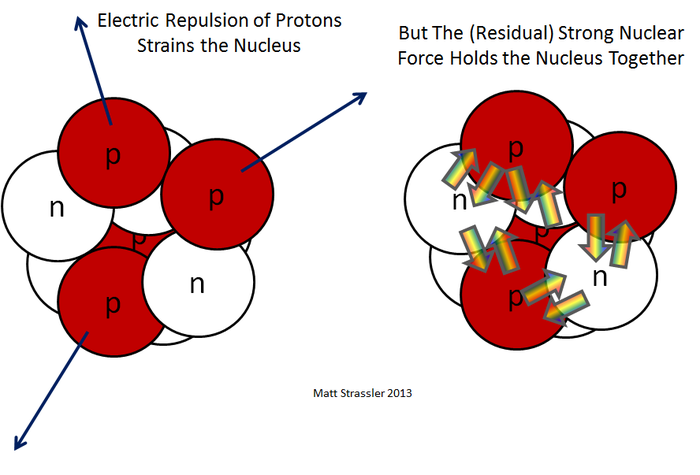The strong nuclear force and electromagnetism, while distinct in their origins and manifestations, share several profound similarities that invite intriguing comparisons. Both forces are fundamental to the fabric of the universe and are integral to the underlying interactions between particles. This exploration aims to elucidate these parallels, casting light on their respective roles within atomic and subatomic realms.
To begin with, both the strong nuclear force and electromagnetism are fundamental interactions discovered in the early context of modern physics. Each operates at the heart of atomic structure; the strong nuclear force binds protons and neutrons within atomic nuclei, while electromagnetism governs the interactions between charged particles, such as electrons and protons. This binding and interaction create a harmonious existence that forms the underpinning of matter as we know it.
The strong nuclear force, mediated by gluons, operates at an astonishing short range, approximately 1 femtometer (10-15 meters). This force is remarkably potent, significantly surpassing the electromagnetic repulsion experienced between positively charged protons. Imagine a cosmic glue that holds the very essence of matter together—it mandates the stability of the nucleus, ensuring that atomic structures endure despite the fierce electromagnetic repulsion. On the contrary, the electromagnetic force is omnipresent, extending across vast distances. It operates between negatively charged electrons and positively charged nuclei, facilitating the formation of the diverse chemistries that lead to the myriad substances surrounding us.
Both forces also exhibit characteristics that define their underpinning behavior. For instance, the strong nuclear force is characterized by its non-linear nature and peculiar distance dependence. In contrast to electromagnetism, which diminishes with the square of distance, the strong force behaves in a collectivity-oriented manner; it strengthens as quarks group together, akin to a dancer’s hold growing firmer with the tighter embrace of partners in motion. This phenomenon, referred to as confinement, is a distinguishing hallmark of the strong nuclear force, demonstrating how quarks remain tethered within protons and neutrons, much as particles in a tightly-knit social network.
Furthermore, both forces embody an eleventh dimension of symmetry and conservation. They exhibit gauge symmetry—an elusive quality that defies spatial and temporal convention. Electromagnetism resonates with U(1) gauge symmetry, while the strong force correlates with SU(3) gauge symmetry, resulting in the complex interactions that govern particle behavior. This symmetry is pivotal, enabling particle physicists to decipher the rules of interaction and establish conservation laws that govern energy, momentum, and charge—acts of cosmic bookkeeping that remain integral to the functionality of phenomena in the universe.
Mass is another captivating aspect within this discourse. The strong nuclear force generates a significant portion of the mass of ordinary matter through the phenomenon of mass-energy equivalence articulated by Einstein’s proverbial equation, E=mc². While electromagnetism plays a role in the mass of electrons via the Higgs mechanism, it is the strong force that renders the constituents of protons and neutrons bound, contributing to the bulk of the mass we perceive in everyday life. This interplay between mass and force illuminates a profound symbiotic relationship, one where neither could fully express its identity without the other’s interaction.
In the realm of visual metaphors, consider the strong nuclear force as a mighty river that fuels the lush landscapes surrounding it. Without the river’s continual flow and nurturing embrace, the life that flourishes would dwindle. Electromagnetism, in this analogy, is akin to the wind that carries seeds across vast distances, facilitating longitudinal connections and interactions. It is this duality that underscores their co-dependence. One sustains structural integrity at the heart of the nucleus, while the other ensures connectivity within wider atomic and molecular interactions.
Delving deeper, the implications of both forces extend to broader arenas of science. The strong nuclear force’s role in fusion reactions powers stars, including our Sun, enabling them to burn brightly and sustain life on Earth. Electromagnetism, on the other hand, is the fountainhead of chemistry, which encapsulates the bonding experiences that construct our solar system’s myriad transitions—from ephemeral gasses to solidified minerals. Together, they orchestrate a symphony of existence, harmonizing the very essence of matter.
It is also essential to acknowledge the challenges scientists face when navigating the intersection of these forces. Quantum Chromodynamics (QCD), which governs the dynamics of the strong force, presents a daunting landscape rife with complexities and non-intuitive behaviors. Similarly, quantum electrodynamics delves into the intricate dance of charged particles, revealing bizarre phenomena such as virtual particles and the uncertainty principle’s sway over relative positions. The mathematical intricacies involved in depicting these forces challenge our comprehension, yet they also illuminate the sublime intricacies of nature.
In conclusion, despite their distinct roles and characteristics, the strong nuclear force and electromagnetism share striking similarities that reflect the fundamental nature of reality. They converge in their symphonic orchestration of atomic structure and explosive phenomena, from the core of stars, to the chemical diversity permeating life itself. The unique, intertwining relationships between these forces invite further exploration and inspire future generations of physicists to unlock deeper secrets that govern our universe.












